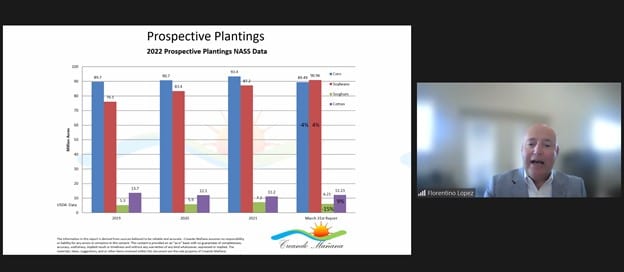| Following the release of its third annual Sorghum Quality Report in March, the U.S. Grains Council (USGC) hosted two virtual rollout events – one for customers in China, Japan, South and Southeast Asia, and another for those in Mexico, Spain and Turkey. During the rollout events, buyers and end-users of sorghum around the world heard from several sorghum subject-matter experts, including Paige Stevenson, USGC manager of global trade. Stevenson reviewed the highlights of the report before taking part in a question and answer session at the end of each event. “Getting up-to-date information is critical for sorghum buyers, especially when most buyers have been unable to travel to the U.S. and see the sorghum crop first-hand,” Stevenson said. “The buyers really value the reliable and in-depth information this report provides them each year.” Norma Ritz Johnson, United Sorghum Checkoff Program (USCP) executive director, welcomed attendees before they heard more about U.S. sorghum and production planting intentions from Florentino Lopez, an agricultural consultant with Creando Mañana, LLC. Ross Janssen, chief meteorologist for KWCH in Kansas, provided a weather outlook for sorghum, and two growers took questions on a sorghum condition report panel. “Buyers are always very interested in hearing directly from the fields themselves, and the growers provided a unique perspective from their own operations. Also, as we approach the growing season, weather is always a big area of interest for anyone following grain production. Having an update from Ross Janssen provided expert knowledge on the weather situation and forecast specifically for the major sorghum growing regions,” Stevenson said. The report found that for the third year in a row U.S. sorghum was, on average, graded above necessary requirements for U.S. No. 1. Protein content in sorghum was up eight percent year over year, with readings coming in at 11.3 percent, up slightly from last year’s crop. Additionally, total sorghum damage came in at 0.0 percent in the aggregate, and broken kernel and foreign material (BNFM) was only 1.5 percent, both similar to last year’s results, highlighting how hard the grain is and how well it holds up during handling and storage. For the second year in a row, 100 percent of the samples tested undetectable for tannins. “The Sorghum Quality Report helps fulfill the Council’s mission of developing markets, enabling trade and improving lives by providing in depth information about the U.S. sorghum crop, allowing buyers around the world an opportunity to see trends in U.S. sorghum quality,” Stevenson said. |
| |||||||||
About The U.S. Grains Council
The U.S. Grains Council develops export markets for U.S. barley, corn, sorghum and related products including distiller’s dried grains with solubles (DDGS) and ethanol. With full-time presence in 28 locations, the Council operates programs in more than 50 countries and the European Union. The Council believes exports are vital to global economic development and to U.S. agriculture’s profitability. Detailed information about the Council and its programs is online at www.grains.org.

